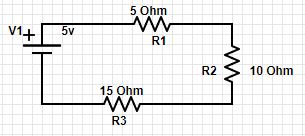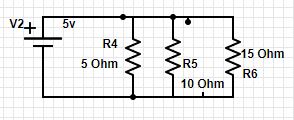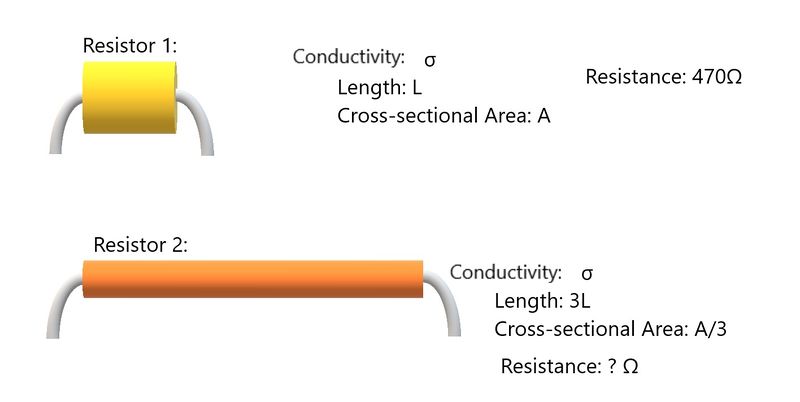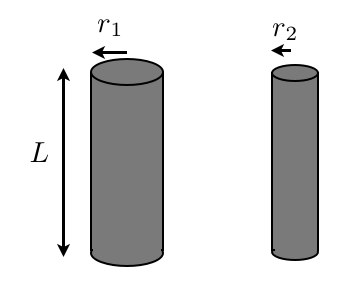Fundamentals of Resistance
Claimed by Benjamin Flamm (Spring 2016)
Edited by Lewey Wilson (Spring 2018)
Resistors are elements that are involved in circuits and oppose the flow of current. The function of a resistor in a circuit is similar to that of a water valve's purpose in plumbing. Like how opening and closing a water valve increases or decreases the flow of water, increasing and decreasing resistance can decrease or increase (respectively) current. The more the valve is closed, the higher the water pressure (voltage in the context of circuits) becomes.
This page gives examples of computing resistance as well as the history and applications of resistors.
The Main Idea
Resistors have many forms throughout modern technology and are applied in electronic industries ranging from basic manufacturing (lightbulbs, portable devices, etc.) to advanced biomedical instrumentation such as electrocardiogram devices. In almost everything, resistance exists but for this page only wires and manufactured resistors are used as examples.
The primary goal of a resistor is to limit the current that flows through a circuit. For example, a lightbulb is a very simple application of Tungsten or another material that has a high resistance. As electrons flow into the lightbulb, they begin to collide with themselves and the high number of charge carriers in the high-resistance filament. The result of these collisions is energy released as light and heat. See the Mathematical Model section for the relationship of these factors and how they determine resistance.
A Mathematical Model
Resistance can be modeled by starting at the fundamental concept [math]\displaystyle{ {I = |q|nA\bar{v}} }[/math] where [math]\displaystyle{ I }[/math] is conventional current, [math]\displaystyle{ |q| }[/math] is the magnitude of the charge being carried, [math]\displaystyle{ n }[/math] is the number of charge carriers, [math]\displaystyle{ A }[/math] is the area of the resistor, and [math]\displaystyle{ \bar{v} }[/math] is the drift speed of the charge.
[math]\displaystyle{ {I = |q|nA\bar{v} = |q|nAuE} }[/math] and [math]\displaystyle{ {J = \frac IA } }[/math] the equation for current density
Grouping the properties of the material together and utilizing the equation for conductivity [math]\displaystyle{ {\sigma = |q|nu} }[/math]:
[math]\displaystyle{ {I = (|q|nu)AE = {\sigma}AE} }[/math]
[math]\displaystyle{ {J = \frac IA = {\sigma}E} }[/math]
Substituting in the equation for electric field we get [math]\displaystyle{ {\frac IA = {\sigma}\frac {{\Delta}V}{L}} }[/math]
Finally, using algebra we attain [math]\displaystyle{ {I = \dfrac{{\Delta}V}{\dfrac{L}{{\sigma}A}} = \frac {{\Delta}V}{R}} }[/math]
Resulting in the definition of resistance being [math]\displaystyle{ {R = \dfrac {L}{{\sigma}{A}}} }[/math]
Although resistance can be easily derived and calculated, the majority of problems that contain resistance involve circuit analysis and Ohm's Law [math]\displaystyle{ {{\Delta}V = IR} }[/math] in which resistance is usually provided beforehand.
A Computational Model
Given a diagram consisting of a thinner wire leading into a thicker wire and then back through a thinner wire, it is possible to visualize how the cross-sectional area of a wire affects its resistance. The two thin sections of wire are identical and labeled with areas [math]\displaystyle{ {A_1} }[/math] and the thick section of wire has an area of [math]\displaystyle{ {A_2} }[/math].
Charge carriers (electrons in the diagram above) are flowing through the three wires with the same charge but are forced to pass through regions with varying cross-sectional areas. Analyzing the equation [math]\displaystyle{ {R = \dfrac {L}{{\sigma}{A}}} }[/math] it is obvious that resistance is inversely proportional to its cross-sectional area but observing the above diagram gives a more solidifying explanation of why this relationship exists.
So let's say electron flow is from left to right; traveling through the first thin wire, the thick wire, and then finally exiting through the second thin wire. The charge of these electrons are equal throughout each individual wire, as well as the number of charge carriers and the mobility of these charges. Observing the diagram, you can see that the electron flow is more dense in the thinner wires. This is due to the fact that the electrons have less room to move around and are constantly colliding with each other (makes sense, less area:more crowded). In the thick wire, the same amount of electrons are passing through but with much more space which means less collisions and ultimately less resistance.
Ohmic and Non-Ohmic Resistors
Not all resistors (or circuit components in general) are ohmic, meaning that conductivity (σ) is constant and independent from the amount of current flowing through the resistor. As a result, resistance R is constant. Though no materials are truly ohmic, the ones that are considered ohmic experience very little change in their conductivity and approximately conform to Ohm's law ([math]\displaystyle{ {{\Delta}V=IR} }[/math]). Materials and, by extension, resistors made from materials that have conductivities that change based on current are considered non-ohmic. Outside of resistors and anything specifically stated to have a constant resistance, most components, such as batteries, capacitors, light bulb filaments, and especially semiconductors, are non-ohmic.
Important Note About Series and Parallel Resistors
In a circuit:
When multiple resistors are in series, the total resistance is
[math]\displaystyle{ {R_s = R_1 + R_2 + R_3 + R_n +...} }[/math]
When multiple resistors are in parallel, the total resistance is
[math]\displaystyle{ {R_p = (\dfrac {1}{{R_1}} + \dfrac {1}{{R_2}} + \dfrac {1}{{R_3}} + \dfrac {1}{{R_n}} + ...)^{-1}} }[/math]
For More Details: Parallel Circuits vs. Series Circuits*
Examples
Simple
Both of these circuits are connected to a 5V battery and contain 3 resistors ([math]\displaystyle{ 5\Omega , 10\Omega , 15\Omega }[/math]). What are the total resistances and current of these circuits?
Solution
1.
a. [math]\displaystyle{ {R_s = 5\Omega + 10\Omega + 15\Omega = 30\Omega} }[/math]
b. [math]\displaystyle{ 5V = I * 30\Omega ; I = \dfrac {1}{{6}} = 0.1667 A }[/math]
2.
a. [math]\displaystyle{ {R_p = (\dfrac {1}{{5\Omega}} + \dfrac {1}{{10\Omega}} + \dfrac {1}{{15\Omega}})^{-1}} = 2.727\Omega }[/math]
b. [math]\displaystyle{ 5V = I * 2.727\Omega ; I = \dfrac {5V}{{2.727\Omega}} = 1.833 A }[/math]
Middling
An ohmic resistor has a resistance of 470Ω. It has a length L, cross-sectional area A, and conductivity σ. Another resistor is made out of the same material, but has 3 times the length and 1/3rd of the cross-sectional area.
1) What is the resistance of the second resistor?
2) What is the combined resistance of the two in series?
3) in parallel?
Solution
1) [math]\displaystyle{ {R_1 = \dfrac {L}{{\sigma}{A}}} }[/math] ; [math]\displaystyle{ {R_2 = \dfrac {3L}{{\sigma} * {1/3 * A}}} = \dfrac {3}{1/3} * \dfrac {L}{{\sigma}{A}} = 9 \dfrac {L}{{\sigma}{A}} }[/math] = [math]\displaystyle{ 9 * 470 = 4230\Omega }[/math]
2) [math]\displaystyle{ R_s = \dfrac {L}{{\sigma}{A}} + 9\dfrac {L}{{\sigma}{A}} = 10\dfrac {L}{{\sigma}{A}} = 4700\Omega }[/math]
3) [math]\displaystyle{ {R_p = (\dfrac {1}{{470\Omega}} + \dfrac {1}{{4,230\Omega}}})^{-1} = {\dfrac {1}{{423\Omega}}}^{-1} = 423\Omega }[/math]
Difficult
Calculate the resistance of a copper wire with length of [math]\displaystyle{ 10m }[/math] and a diameter, [math]\displaystyle{ d }[/math], of [math]\displaystyle{ 1.63mm }[/math] (conductivity of copper is [math]\displaystyle{ {\sigma} = 1.7{e^-8} }[/math])
Given that [math]\displaystyle{ {d = 1.63mm} }[/math], we can find the cross-sectional area of the wire [math]\displaystyle{ {A = \pi{r^2} = 2.56{e^-6}{m^2}} }[/math]
Now we have the length, conductivity, and area which is sufficient to solve the equation [math]\displaystyle{ {R = \dfrac {L}{{\sigma}{A}} = \frac {10}{4.352e-14} = 2.29 \Omega} }[/math]
How does the resistance of the thin wire (copper) with radius [math]\displaystyle{ {r_1 = 8r_2} }[/math] compare to the resistance of the thick wire (nichrome)? The conductivity of copper is [math]\displaystyle{ {\sigma} = 1.7{e^-8} }[/math] and nichrome is [math]\displaystyle{ {\sigma} = 1{e13} }[/math]
We know that resistance is defined as [math]\displaystyle{ {\dfrac {L}{{\sigma}{A}}} }[/math] so relating the resistance equations for these two wires we get
[math]\displaystyle{ {\dfrac {8L}{{\sigma}{A}} = \dfrac {L}{{\sigma}{A}}} }[/math] and substituting in the values for conductivity we get the ratio [math]\displaystyle{ { 1.5625{e^-15}{L_1} = {5.95e7}{L_2} } }[/math]
From these numbers it is very clear that the resistance of the copper wire is very high due to its small area and low conductivity.
Connectedness
Resistors are the cornerstone of circuitry. Any given electronic device won't have just one, but many resistors in order to regulate current throughout the device. Even in components not specifically labelled "resistors," variable (or adjustable) resistors are used for many purposes, most notably in input devices. Although they have a simple purpose (limiting current flow) they have a very important application in power system projects of all kinds. For example, engineers have returned to the fundamentals of voltage and resistance when designing basic grid systems for developing countries.
Electrical and Computer Engineering students use wire wound resistors every semester, and for the rest of their careers, in order to build circuits involving push-buttons or any type of active-low/active-high switches.
The purpose of resistance in industry is extremely broad and has many fascinating applications in everyday electronics like the laptop or smartphone one may read this article on, to the flight decks of passenger jets.
History
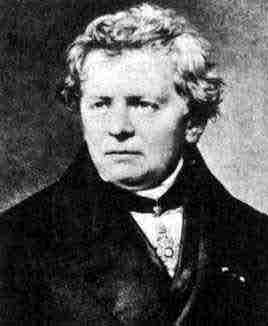
Resistance was first observed by the German physicist Georg Ohm in 1827. Ohm conducted meticulous experiments while teaching at the Jesuit's College in Cologne, Germany. Although he was teaching mathematics classes, Ohm was primarily interested in electricity and conducted research to study the characteristics of electron flow. For these experiments, he gathered wires of different gauges, lengths, and materials through which he was able to run current and define the famous relationship we now refer to as Ohm's Law. It states that "the amount of steady current through a material is directly proportional to the voltage across the material, for some fixed temperature" and is mathematically written as [math]\displaystyle{ {{\Delta}V=IR} }[/math].
See also
Parallel Circuits vs. Series Circuits*
Further reading
Resistor Color Code Calculator and Chart
References
Chabay, Ruth W. Matter and Interactions: Electric and Magnetic Interactions. Place of Publication Not Identified: John Wiley, 2015. Print.

